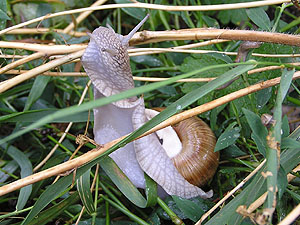
The cumbersome path of a Roman snail through the under-
growth shows us the snail's foot sole. [RN]
Though snails and slugs (Gastropoda) make the most various group and also the richest in species among all molluscs (Mollusca), their locomotion can usually be deducted to one specialised organ common to all their basic body plans.
 The cumbersome path of a Roman snail through the under- growth shows us the snail's foot sole. [RN] |
The so-called foot is the largest part of a gastropod's body visible outside of the shell. Most gastropods' foot is developed to a flat crawling sole at its lower (ventral) side. This points to the most frequent way of snail locomotion: Crawling.
We know this method of locomotion best from terrestrial snails, simply because those are most often observed, at least with the right weather prevailing. We have described already, using the example of the Roman snail (Helix pomatia), how locomotion works in a gastropod: The snail makes wave-like movements of the sole, which carry its body forward.
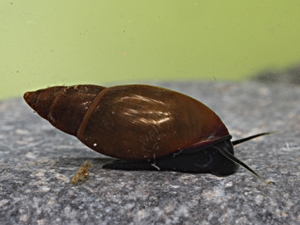 Moss bladder snail (Aplexa hypnorum). Picture: © Alexander Mrkvicka, Vienna (mrkvicka.at). |
As snails move in a specified direction, other than, for example, their relatives, the mussels and clams (Bivalvia), they also developed a head at the front end of the foot, with most of the snail's sense cells and organs, with tentacles and eyes. It is hard to see, where the head ends and the foot begins, so both together are called a head-foot or cephalopodium, which is a typical character of all gastropods.
![]() Locomotion of a terrestrial snail (Roman snail Helix pomatia).
Locomotion of a terrestrial snail (Roman snail Helix pomatia).
![]() Movie:
Ventral side of a crawling snail
(Cornu aspersum). [RN]
MOV-File, ca. 2 MB.
Movie:
Ventral side of a crawling snail
(Cornu aspersum). [RN]
MOV-File, ca. 2 MB.
Where they crawl, snails leave behind a characteristic, proverbial slime trace, because a large gland at the foot sole's front end produces large amounts of mucus the snail crawls on. The mucus reduces friction between the foot sole and the ground, enabling the snail to perform such astonishing acts as to crawl unharmed over a knife's edge.
The speeds gastropods are able to achieve with this type of locomotion are different: The Roman snail (Helix pomatia) may be as fast as 7 cm/min (2.5 in/min). Water snails usually are faster: The pond snail (Lymnaea stagnalis) may be as fast as 12 cm/min (4.8 in/min) and the predatory whelk (Buccinum undatum) in pursuit of its prey may reach 16 cm/min (6.4 in/min). Really amazing is the speed of bladder snails (Physidae). Those small freshwater snails can move through the water at about 20 cm/min (8 in/min). The fastest species is said to be the moss bladder snail (Aplexa hypnorum), awaiting confirmation.
Many terrestrial snails, among those notably the Roman snails, use their foot not only for locomotion in the narrower sense but also for burrowing in the ground. There are even numerous carnivorous terrestrial snails, such as the shell slugs (Testacellidae) and the Daudebardias (Daudebardiinae). Both mainly live underground and hunt earthworms.
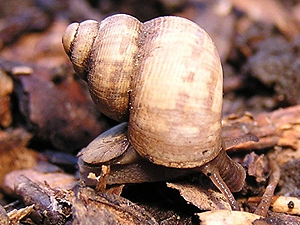 A round mouthed snail (Pomatias elegans) with its operculum. Picture: Michael Stemmer. |
 A pond snail crawling below the water surface and feeding on algae. [RN] |
A special case among terrestrial snails are the terrestrial operculate snails, such as the round mouthed snail (Pomatias elegans). Those have evolved from ancestors other than those of the pulmonate land snails (Stylommatophora), among which the Roman snail is to be placed. That is why their method of locomotion is a bit different: Their foot sole is divided in half longitudinally and the round mouthed snail moves both halves separately, so it seems to move almost like on two feet.
Not only terrestrial snails move crawling on their foot. A limpet (Patella vulgata) clinging to a rock during low tide will crawl around to look for food during high tide. And so does a whelk (Buccinum undatum) on the hunt for prey, only it is about its business in a much faster way. Some carnivorous sea gastropods also use their foot to prevent a mussel from closing its shell halves while they feed on the inhabitant.
Observing terrestrial snails one has but to come to the conclusion all snails crawl around on the ground. That may be the case with terrestrial snails, but it is not necessarily with water snails. Freshwater snails, such as the pond snails (Lymnaeidae) can crawl on the water surface's underside! The pallial cavity filled with air (pond snails are pulmonate snails breathing oxygen from the air) gives them buoyancy and together with their slime trace the water's surface tension is sufficient to support their weight, so they can even graze algae floating there.
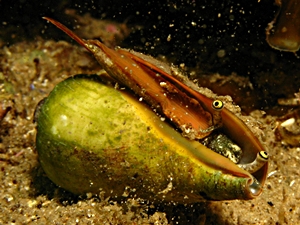 A juvenile of Strombus luhuanus. Quite well visible: The sabre- like operculum at the foot tip (upper left). Picture: Richard Ling (Quelle). |
Some gastropods living on the ground not always move in a crawl. Conches (Strombidae) also use their sabre-shaped operculum. Their operculum dug into the ground, they catapult themselves forward, so they jump over the ocean floor. When they are threatened, they can also use their operculum to deal painful blows.
![]() Ulrich Wieneke, Han Stoutjesdijk
and Philippe Simonet:
Gastropoda - Stromboidea: A very rich homepage on conches and their
relatives.
Ulrich Wieneke, Han Stoutjesdijk
and Philippe Simonet:
Gastropoda - Stromboidea: A very rich homepage on conches and their
relatives.
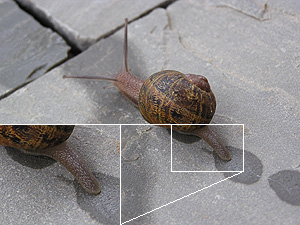 "Jumping" Cornu aspersum (see text). [RN] |
On the other hand, some terrestrial snails are said to jump as well. But that means something else entirely: Many terrestrial snails, such as a common garden snail (Cornu aspersum) have to fear water loss because of evaporation during dry weather. So they only touch the ground with parts of their foot sole and leave behind a discontinuous, seemingly dashed, slime trace. But of course, they do not really hop around.
The so-called jumping slugs (Hemphillia dromedarius) on the other hand, are small slugs living on the the Pacific coast of the northeastern USA and southeastern Canada. Those, when trying to evade predators, such as the robust lancetooth snail (Haplotrema vancouverense), flap their tails vigorously and wriggle their bodies, so they "jump" out of harm's way.
The following movie by BBC Earth very finely shows how a tulip snail (Fasciolaria tulipa), by the way a predator itself, attempts to escape a giant horse conch (Pleuroploca gigantea).
![]() Giant Horse Conch and Burglar Hermit Crabs!
Quelle: BBC Earth auf
YouTube.
Giant Horse Conch and Burglar Hermit Crabs!
Quelle: BBC Earth auf
YouTube.
But Pleuroploca gigantea, to the unlucky tulip snail's disadvantage, is the largest gastropod species in the western hemisphere. Though it is called a "horse conch" in English, it is not a conch (Strombus), but a relative of the European common whelk (Buccinum undatum).
Many sea snails have developed another method of locomotion: While many species crawl around on the ocean floor, protected by a heavily armed shell, the former species have discarded the protective shell for the advantage of better mobility.
The sea hare (Aplysia depilans) for instance is a sea gastropod which has its name because of its tentacles looking like hares' ears. But also its foot's rim is extended like wings. Those fin-like appendages (parapodia) can be formed into a funnel by the snail, through which it can press water afterwards and so swim around in the ocean floor's vegetation such as sea weed. A sea hare does possess a shell, but it is very light, thin-walled and protected by the mantle.
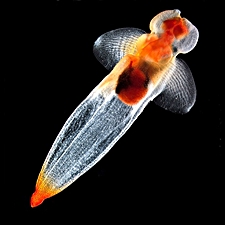
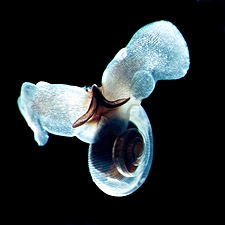 Left: Sea angel (Clione limacina). Right: Sea butterfly (Limacina helicina). Pictures: Russ Hopcroft (Arctic Ocean Diversity). |
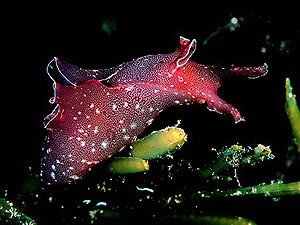 This sea hare's (Aplysia punctata) parapodia are folded in res- ting position over the snail's back. Picture: Erling Svensen. |
Other marine gastropods have perfected the art of swimming and in so doing dispense with all their shell protection. The gastropod Limacina helicina also called a sea butterfly, has changed its foot into two great parapodia, with the help of which it gets enough buoyancy to float through the water. Sea butterflies feed on plankton, small crabs and gastropod larvae they catch from the water with a slime net.
The large numbers of sea butterflies on the other hand are prey to another swimming species of sea gastropod, the sea angel, Clione limacina. This marine gastropod owes its name to its large wing-like parapodia. It also feeds on jellyfish, whose nettle cells (Nematocytes) are of little effect against the snail's slime.
A special method of swimming has been developed by the violet snail (Janthina janthina). It swims using a self-built float of mucus bubbles. The violet snail itself is unable to swim, but using the float it remains at the sea surface, where it hunts for jellyfish, as does Clione.
Last Edit: 17.09.2022 (Robert Nordsieck).